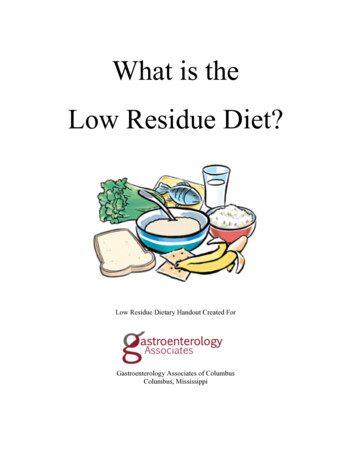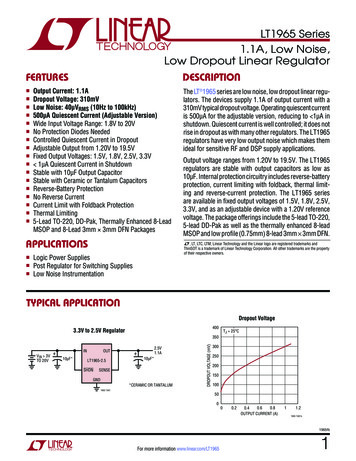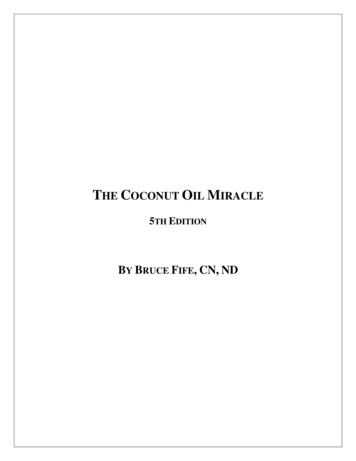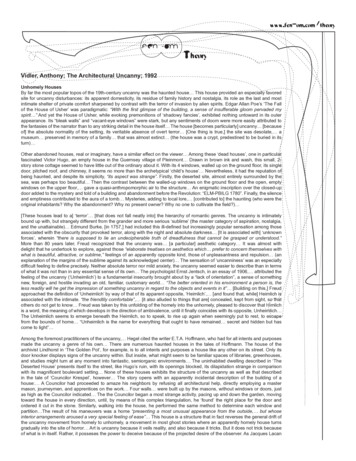
Transcription
What is theLow Residue Diet?Low Residue Dietary Handout Created ForGastroenterology Associates of ColumbusColumbus, Mississippi
What is it?The low-residue diet is designed to increase intestinal transit time whilereducing the frequency and volume of fecal output thus reducingirritation in the gastrointestinal tract. This diet is recommended for someinflammatory conditions such as Crohn’s disease, diverticulitis, or whenthere is narrowing of the bowel due to a tumor, after surgery, or duringradiation treatment.Residue is the indigestible and nonabsorbable food in the large intestine.Primarily this is dietary fiber, a natural part of fruits, vegetables, andgrains. Limiting the amount of dietary fiber reduces the amount ofindigestible food in the large intestine.Low-residue and low-fiber terms are often used interchangeable and they are very similar but have somedifferences. A low fiber diet is a normal diet with a reduced amount of fiber (less than 10-15g of fiber)whereas the low residue diet includes the low fiber diet and some other foods that are high residue but lowfiber. For example, milk doesn’t have any fiber but can leave a residue in the large intestines.1Foods to Avoid Whole-grain or whole wheat productsBrown or wild riceOats, Barley, and QuinoaRaw fruit (including those with seeds, and skin such as berries)Raw or undercooked vegetables (including corn and winter squash) Dried beans, peas, and lentilsSeeds and nutsFoods made with seeds, nuts, raw or dried fruitCoconutPopcornPickles, relish, and olivesLimit milk and milk products to 2 cups daily2Broccoli, cauliflower, brussel sprouts, cabbage,kale, and swiss chardAlso be sure to read food labels, some foods like yogurt, icecream, cereal, and some beverages can have added fiber. Try to find foods that have less than 1 gram offiber in a serving.
Recommended FoodsBreads and GrainsRefined breads, toast, rolls, biscuits, muffins, crackers, pancakes, wafflesEnriched white or light rye bread and rollsSaltine crackersRefined cereals (puffed rice, puffed wheat, Rice Krispies, Corn Flakes, Cheerios, Cream ofWheat)White rice, refined pasta, macaroni, noodlesVegetablesCanned or well cooked vegetables without seeds, hulls, or skins. Carrots Asparagus Beets Green or wax beans Pumpkin Spinach Squash without seeds Potatoes without skin TomatoesFruitsMost canned or cooked fruits without skins, seeds, or membranes Fruit cocktail Avocado Canned applesauce Apricots, peaches, or pears without skin and seeds Pureed plums Ripe bananas Fruit juices with no pulpMilk and DairyLimit products to 2 cups per dayMild cheese, cottage cheese, etc.Yogurt with no berriesButter and margarineMeatEggsGround, tender, or well-cooked meat productsCreamy peanut butter (limit to 2 tbsp per day)How to Prepare FoodsThe goal is to prepare foods that are tender. Simmering, poaching, stewing, steaming, braising, baking, ormicrowaving are all good options.Avoid roasting, broiling, or grilling as these make foods dry and tough which increase the amount ofindigestible material. You may also want to avoid fried or spicy foods as these can be irritating to theintestinal tract.
Sample Meal OptionsBreakfast:White bread toast with jam, 2 scrambled eggs, and a glass of fruit juiceCream of wheat with banana slicesCheerios or Rice Krispies with ½ cup of milkPancakes or waffles made with white flourPoached eggs with english muffinLunch:Ham and cheese sandwich on white breadEgg salad sandwiches on white breadMacaroni and cheeseHamburger with white bun and melon slicesDinner:Baked chicken breast with steamed carrotsMashed potatoes, baked fish, and cooked green beansRoast beef (cooked until tender), white rice, and cooked zucchiniMeatloaf and baked potato (no skin)Snacks:Peanut butter and jelly on white breadApplesauceHard Boiled eggsPackaged fruit cupsSaltine crackersBrands and Snack IdeasRice KrispiesCheeriosSpecial KNabisco Saltine CrackersCream of WheatV8 juices without pulpJello puddingsOther ResourcesThe Low Residue Diet Cookbook by Monika ShahThe Low Fiber Diet by Anna Keating
TipsHave SupportStarting on this journey can be stressful so make sure you have support! Talk withyour friends and family, having their support goes a long way towards stickingwith a low-residue diet. Also be sure to talk with your physician about anyconcerns or questions you have!Be ReadyGet the best, up to date resources to help you on this journey. There are a lot ofonline resources to help you identify low-residue foods.READ LABELS!There are so many ways companies sneak added fiber or whole grains into foods. It is important tomake sure you are reading all labels to look for ingredients that indicate hidden fiber or whole grainproducts!Meal PlanMaking changes to your diet seem overwhelming and time consuming.Taking time at the beginning of the week to meal plan and write out agrocery list can save time later in the week and ensure you have allingredients you need.Have Some AlternativesTransitioning to a low-residue diet can be easier if you have somealternatives to swap out whole grain or high fiber/residue foods innormal recipes!Trying stocking your kitchen with white flour, canned fruits and vegetables,and other packaged low residue foods so you are always prepared!References1. Proceeding of Singapore Healthcare. Low Residue Diet in Gastrointestinal Conditions. 2012;21(3). Available /pdf/10.1177/201010581202100304 Accessed August 23, 2018.2. Low-fiber diet do’s and don’ts. Mayo Clinic. Available at t20048511. Accessed August 23, 2018.3. Low-Residue Diet. GI Associates & Endoscopy Center. Available at https://gi.md/resources/low-residue-diet. Accessed August 23, 2018.
differences. A low fiber diet is a normal diet with a reduced amount of fiber (less than 10-15g of fiber) whereas the low residue diet includes the low fiber diet and some other foods that are high residue but low fiber. For example, milk doesn’t have any fiber but can










